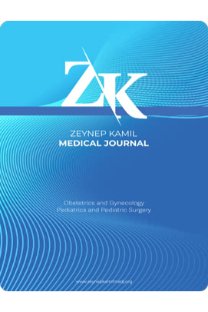Prematüre Retinopatisi: Sıklık Azalıyor mu?
Retinopathy of Prematurity: Is there a Decline in Incidence
___
- 1. FiersonWM; American Academy of Pediatrics Section on Ophthalmology; American Academy of Ophthalmology; AmericanAssociation for Pediatric Ophthalmology and Strabismus; American Association of Certified Orthoptists. Screening examination of premature infants for retinopathy of prematurity. Pediatrics. 2013;131(1):189-95
- 2. Sarıcı SÜ,MutluFM,AltınsoyHİ. Prematüre retinopatisi. Çocuk SagligiHast.Derg. 2008;51:51-61.
- 3. Altan T, Ovalı F, Eser İ, Uysal S, Acar N, Atay E, Ünver YB, Kapran Z. Yenidoğan yo- ğun bakım ünitesinde taranan bebeklerde prematüre retinopatisi sıklığı ve ilişkili faktörler. Ret-Vit. 2008;16:269-72.
- 4. ReynoldsJD, HardyRJ, Kennedy KA, Spencer R, van Heuven WA, Fielder AR; Light Reduction in Retinopathy of Prematurity (LIGHT-ROP) Cooperative Group. Lack of efficacy of light reduction in preventing retinopathy of prematurity. N Engl J Med. 1998;338(22):157276
- 5. ReynoldsJD, Dobson V, Quinn GE, et al; CRYO-ROP and LIGHT-ROP Cooperative Study Groups. Evidence-based screening criteria for retinopathy of prematurity: natural history data from the CRYO-ROP and LIGHTROP studies. Arch Ophthalmol. 2002;120 (11):147076
- 6. EarlyTreatment for Retinopathy of Prematurity CooperativeGroup. Revised indications for the treatment of retinopathy of prematurity. Results of the early treatment for retinopathy of prematurity randomized trial. Arch Ophthalmol 2003;121(12):168496
- 7. Screening examination of premature infants for retinopathy of prematurity. A joint statement of the American Academy of Pediatric, the American Association for Pediatric Ophthalmology and Strabismus, and the American Academy of Ophthalmology. Ophthalmology. 1997;104:888-89
- 8. An International Committee for the Classification of Retinopathy of Prematurity. The International Classification of Retinopathy of Prematurity revisited. Arch Ophthalmol. 2005;123(7):991-9.
- 9.Gilbert C, Foster A. Childhood blindness in the context of VISION 2020the right to sight. Bull World Health Organ. 2001;79(3):227 32.
- 10. Özcan A, Soylu M, Demircan N, Satar M, Narlı N.Prematüreretinopatisi gelişimindeki risk faktörleri ve tedavi sonuçları. Türk Oftalmol. Gaz. 1997;27: 290-94.
- 11. FleckBW, McIntosh N. Pathogenesis of retinopathy of prematurity and possible preventive strategies. Early Hum Dev. 2008;84(2):83-8
- 12. Yalaz M, Arslanoğlu S, Erakgün ET, Yurtsever SN, Akisu M, Akkın C, Menteş J, Kültürsay N. Prematüre Retinopatisi Risk Faktörleri ve Koruyucu Önlemler. Turk.Klinikleri J. Pediatr 2003;12(1):1-8
- 13. Sönmez K, Özcan PY, İlhan B, Altıntaş AK. Yenidoğan Yoğun Bakım Ünitesindeki Bebeklerde Prematüre Retinopatisi Sıklığı, Gelişiminde Etkili Risk Faktörleri ve Tedavi Sonuçları. Ret-Vit. 2011;19(4):225-30.
- 14. Öner A, Özkırış A, Güneş T, Karaküçük S, Erkılıç K, Çetin N. Prematüre Retinopatisi: 2 yıllık tarama sonuçlarımız. Erciyes Tip Derg. 2005;27(3):104-9.
- 15. Kavurt S, Yücel H, Hekimoğlu E, Baş AY, Demirel N, Türkbay D. Prematüre retinopatisi gelişen olgularda risk faktörlerinin değerlendirilmesi. Çocuk SagligiHast. Derg. 2012;55:125-31.
- 16. Özbek E, Genel F, Atlıhan F, Güngör İ, Malatyalı R, Menteş J, Berk T. Yenidoğan yo- ğun bakım ünitemizde prematüre retinopatisiinsidansı, risk faktörleri ve izlem sonuçları. Behcet Uz CocukHast. Derg. 2011; 1(1):7-12
- 17. PalmerEA, Flynn JT, Hardy RJ, et al. Incidenceandearlycourse of retinopathy of prematurity. The Cryotherapy for Retinopathy of Prematurity Cooperative Group. Ophthalmology 1991;98:1628-40.
- 18. Scalif-Delfos NE, CatsBP. Retinopathy of prematurity: the continuing threattovision in preterminfants . Dutch survey from 1986 to 1994. Acta Ophthalmol Scan 1997;75:72-75
- 19. FledeliusHC, KjerB.Surveillanceforretinopathy of prematurity in a Danishcountry. Epidemiological experience over 20 years. ActaOphthalmolScand. 2004;82:38-41
- 20. Charan R, DograMR, Gupta A, et al. Theincidence of retinopathy of prematurity in a neonatal care unit. Indian J Ophthalmol. 1995;43:123-26.
- 21. PhanMH, NguyenPN, ReynoldsJD. Incidence and severity of retinopathy of prematurity in Vietnam, a developing middle-income country. J Pediatr Ophthalmol Strabismus. 2003;40:208-12.
- 22. Mintz-Hittner HA, KuffelRRJr. Intravitrealinjection of bevacizumab (avastin) for treatment of stage 3 retinopathy of prematurity in zone I orposteriorzone II. Retina. 2008;28(6):831-8
- 23. Mintz-Hittner HA. Treatment of retinopathy of prematurity with vascular endothelial growth factor in hibitors. Early Hum Dev. 2012;88(12):937-41
- 24. WuWC, KuoHK, YehPT, Yang CM, Lai CC, Chen SN. An updatedstudy of theuse of bevacizumab in thetreatment of patientswithprethresh old retinopathy of prematurity in Taiwan. Am J Ophthalmol. 2013;155(1):150- 58
- 25. HarderBC, vonBaltz S, SchlichtenbredeFC, JonasJB. Early refractive outcome after in travitreous bevacizumab for retinopathy of prematurity. Arch Ophthalmol. 2012;130(6):800-1
- ISSN: 1300-7971
- Yayın Aralığı: 4
- Başlangıç: 1969
- Yayıncı: Ali Cangül
ŞULE AYLA, Gülperi ÖKTEM, GAMZE TANRIVERDİ, Ayhan BİLİR
Prematüre Retinopatisi: Sıklık Azalıyor mu?
MURAT GÜNAY, SEVİLAY TOPCUOĞLU, Gökhan ÇELİK, Tuğba GÜRSOY
İncebarsak Mezosunda RIA: Nadir Bir Olgu
Zehra Nihal DOLGUN, Rakhshanda ASLANOVA, Emrah TURHAN, Niyazi Cenk SAYIN
-Postmenapozal Nadi̇r Görülen Bi̇r Over Tümörü: Endometri̇oi̇d Ki̇stadenofi̇brom (Olgu Sunumu)
SÜLEYMAN MURAT BAKACAK, Özge KIZILKALE, RUKSET ATTAR, Gazi YILDIRIM, M. Sühha BOSTANCI, Elif BAĞLAM, Cem FIÇICIOĞLU
Body Stalk Anomalisi : Olgu Sunumu
Mesut POLAT, Resul ARISOY, Emre ERDOĞDU, Özgür Aydın TOSUN, Resul KARAKUŞ, Oya PEKİN, Ahmet Semih TUĞRUL
Emine AKSOY, Alanur Menekşe GÜVEN, Müşerref Sultan MERMER, GÖKHAN CÜCE, Hasan Ali İNAL
Endometrial Polip Ön Tanılı Hastalarda Histeroskopi Sonuçlarımız
HASAN TERZİ, Ahmet KALE, M.Akif SARGIN
Spontan Üçüz Bir Gebelikte Yapışık İkiz
SÜMEYRA NERGİZ AVCIOĞLU, Baran Özhan BAYKAL, SÜNDÜZ ÖZLEM ALTINKAYA, Hasan YÜKSEL, Mert KÜÇÜK, SELDA DEMİRCAN SEZER
Özge KIZILKALE, MUSTAFA EROĞLU, Gazi YILDIRIM, SÜLEYMAN MURAT BAKACAK, M. Sühha BOSTANCI, RUKSET ATTAR, Zeynep BAKACAK, Cem FIÇICIOĞLU
Özofagus Atrezi̇leri̇nde Yoğun Bakım Olanaklarının Sağ Kalım Üzeri̇ne Etkisi
Dolunay ALVER, Ayşenur CELAYİR CERRAH, Oktav BOSNALI, Serdar MORALIOĞLU
